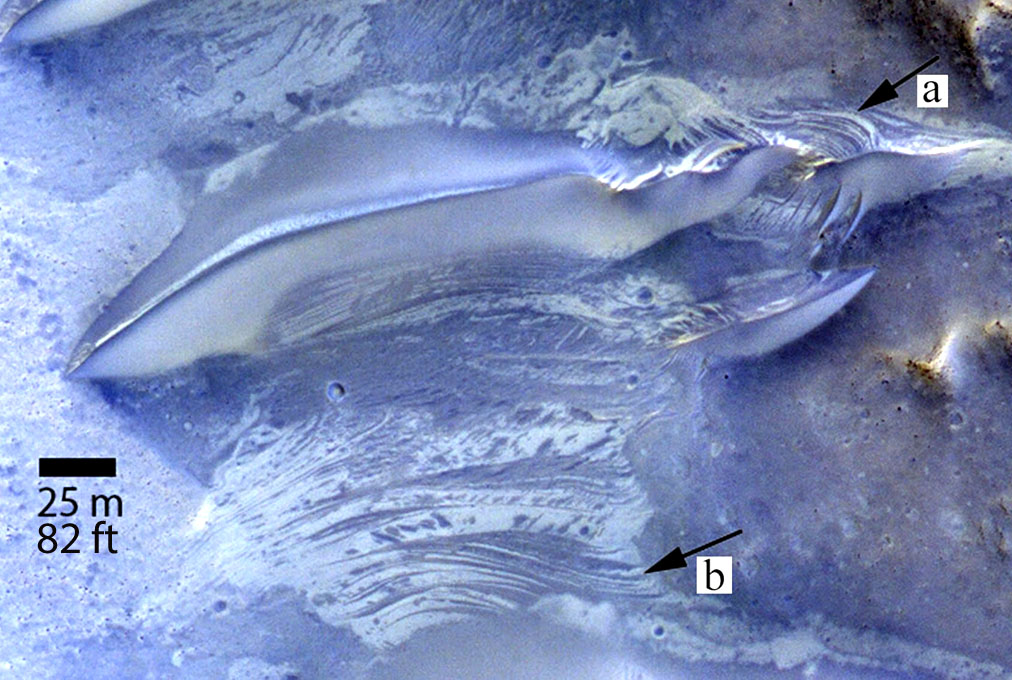
Striations exposed on the surface between Martian sand dunes (one pictured at top) in Lucaya Crater indicate fluctuating levels of salty groundwater. At "a" we see possible cross beds which are tilted layers of sand within larger layers deposited by wind or water. At b, dark and light strata are similar to that exposed in the dune at top and resemble the striations seen in the Namib Desert on Earth. The photo was taken by NASA's Mars Reconnaissance Orbiter in infrared, red and blue light. Credit: NASA/JPL-Caltech
Researcher Dr. Mary Bourke from Trinity College Dublin have discovered a patch of land in an ancient valley in Mars' Lucaya Crater that appears to have held water in the not-too-distant past, making it a prime target to search for past life forms on the Red Planet. Signs of water past and present pop up everywhere on Mars from now-dry, wriggly riverbeds snaking across arid plains to water ice exposed at the poles during the Martian summer.
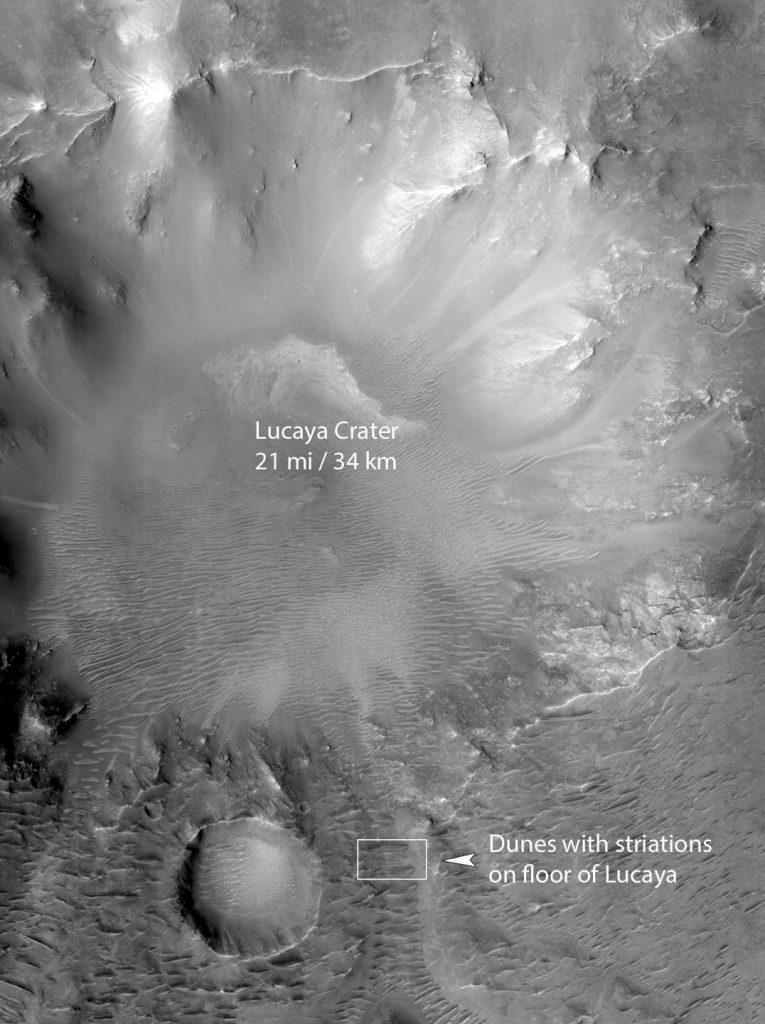
A valley lined with sand dunes crosses the southern floor of the 21-mile-wide Lucaya Crater on Mars. Striations found between the dunes may have been created by recent water flows. The box shows the area pictured in the close up above. The 3.7-mile-long valley measures between 2,000 and 2,600 feet wide. Credit: NASA/JPL-Caltech with additions by the author
On Earth, Bourke had done previous studies of dunes in the Namib Desert near Walvis Bay, Namibia and noted "arctuate striations" — crusty arcs of sand cemented by water and minerals — on the surfaces of migrating sand dunes using photos taken by satellite. She subsequently assembled a team to check them out on the ground and discovered that the striations resulted when dune materials had been chemically cemented by salts left behind by evaporating groundwater.
"On Earth, desert dune fields are periodically flooded by water in areas of fluctuating groundwater, and where lakes, rivers and coasts are found in proximity," said Bourke. These periodic floods leave tell-tale patterns behind them." Once the material had been cemented, it hardens and remains behind as the dunes continue to migrate downwind.
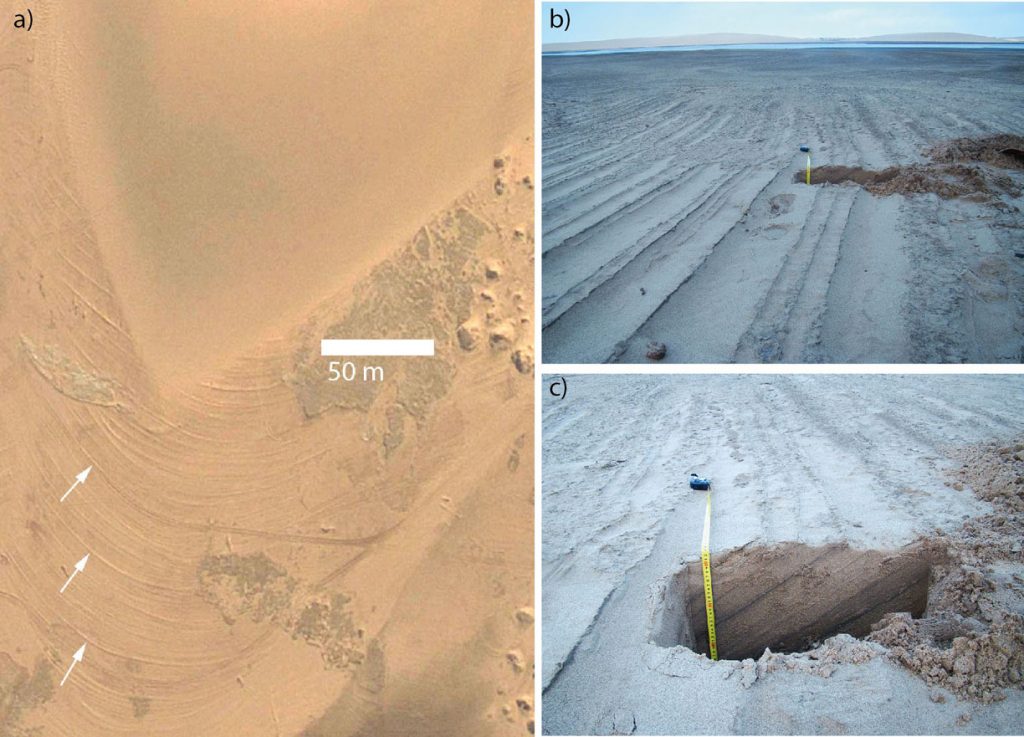
Compare these cemented arctuate striations between dunes near Walvis Bay, Namibia with those in Lucaya Crater's valley in the earlier image. White arrows highlight particularly prominent examples. Photos in (b) and (c) were taken from the ground. The excavated pit in (c) shows that the dipping sediment layers below the surface match the protruding layers on the surface. Alternating light and dark layers have different salt composition and grain size. Credit: Google Earth (left) and Dr Mary Bourke, Trinity College Dublin
Next, Bourke and colleague Prof. Heather Viles, from the University of Oxford, examined close up images of Mars taken with the Mars Reconnaissance Orbiter (MRO) and experienced a flash of insight: "You can imagine our excitement when we scanned satellite images of an area on Mars and saw this same patterned calling card, suggesting that water had been present in the relatively recent past."
Bourke examined similar arcuate striations exposed on the surface between dunes, indications of fluctuating levels of salty groundwater during a time when dunes were actively migrating down the valley.
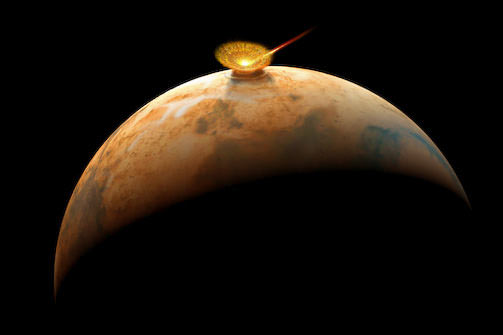
A possible scenario: an asteroid impacts Mars, forming Lucaya Crater and unleashing water flows that created the crater valley and striations.
So where did the water come from to create the striations in the crater valley? Bourke and Viles propose that water may have been released by the impact that formed Lucaya Crater especially if the target area was rich in ice.
Extreme temperatures during the impact would have vaporized water but also possibly melted other ice to flow for a time as liquid water. Alternatively, the impact may have jump-started hydrothermal activity as hot springs-style underground flows.
Flowing water would have created the valley and saturated the soils there with salty water. In dry periods, erosion from the wind would picked away the the water-eroded sands to create the striking pattern of repeating dunes we see to this day.
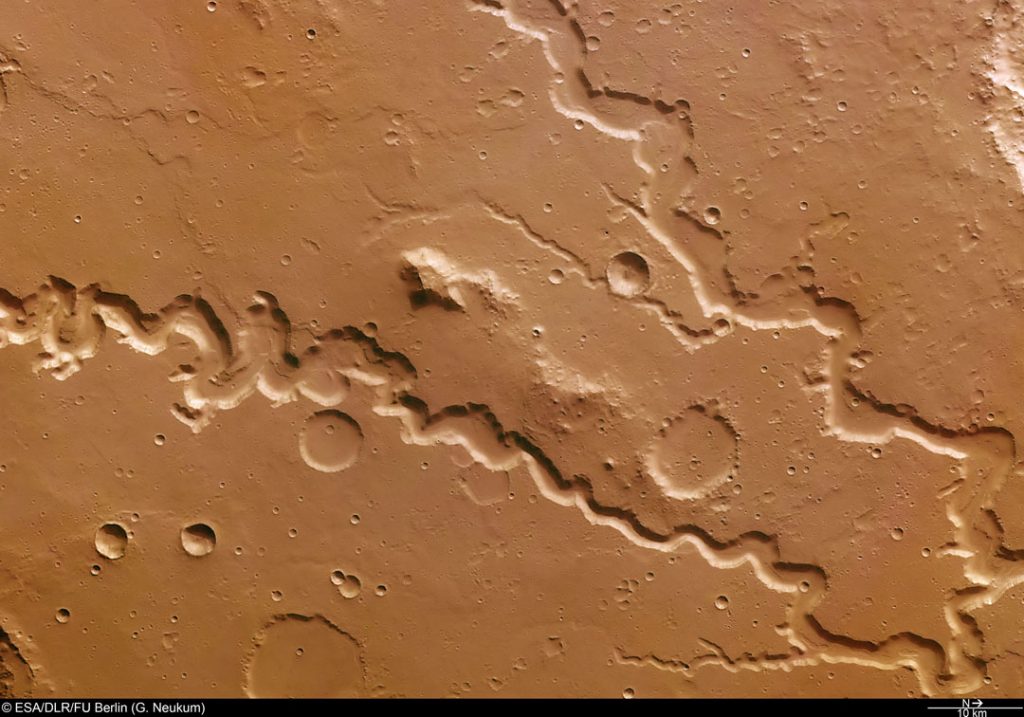
Water, water everywhere ... once upon a time. Nanedi Valles, a roughly 500-mile-long (800 km) valley extending southwest-northeast and photographed by Mars Express. In this view, Nanedi Valles ranges from approximately 0.5 - 3 miles (0.8- to 5.0 km) wide and extends to a maximum of about 1,640 feet (500 meters) below the surrounding plains. The valley's origins remain unclear, with scientists debating whether erosion caused by ground-water outflow, flow of liquid beneath an ice cover or collapse of the surface in association with liquid flow is responsible. In all cases, it's clear that water was involved. Copyright ESA/DLR/FU Berlin (G. Neukum)
Carbonate rocks, which require liquid water to form are dissolved by the same, have been detected in the valley using spectroscopy and could have served as the cement to solidify sands between the moving dunes. That in concert with alternating dry and wet periods would create the striations seen in the MRO photos.
"These findings are hugely significant," said Bourke. "Firstly, the Martian sand dunes show evidence that water may have been active near Mars' equator — potentially in the not-too-distant past. And secondly, this location is now a potential geological target for detecting past life forms on the Red Planet, which is important to those involved in selecting sites for future missions."
No comments:
Post a Comment